We just got back from Pondapalooza in Pittsburgh. The event is hosted by Pond Keeper magazine and features speakers and a water garden industry trade show.
This event was somewhat of a disappointment this year as fewer manufacturers attended. The 2007 Pondapalooza is scheduled for Savannah, Georgia and hopefully participation will increase.
The industry bid farewell to Joe Kalbas of Firestone Building Products as he is retiring. Although Joe is leaving Firestone, rumor has it that he will be working as an independent rep so we will still see him around.
Monday, August 07, 2006
Thursday, July 20, 2006
Went North to escape the heat...
We went to Chicago last week to Aquascape Designs Pond College. It was my fourth year to attend. Pond College consists of three days of classes covering installation, business, retailing and general water gardening.
What I brought home from the conference was that the future is very bright for water gardening. Everyone was upbeat as sales for the industry as a whole have been great this year and we expect next year to be even better.
And yes, the temperatures in Chicago were in the mid 90's all week.
What I brought home from the conference was that the future is very bright for water gardening. Everyone was upbeat as sales for the industry as a whole have been great this year and we expect next year to be even better.
And yes, the temperatures in Chicago were in the mid 90's all week.
Tuesday, June 06, 2006
Tropical Water Lilies
 Tropical water lilies are by far my favorite aquatic plant. Even though they are an annual plant, their performance still make them an excellent investment in your water garden. What makes them so great?
Tropical water lilies are by far my favorite aquatic plant. Even though they are an annual plant, their performance still make them an excellent investment in your water garden. What makes them so great?Blooms, blooms and more blooms. And brillantly colored blooms at that. My favorites are the night blooming lilies that allows working guys like me to enjoy the blooms in the evenings.
- Plant your lilies in a large pot or planting pocket. The more room the lily has to develop its root system the more leaves and blooms it will put off.
- Fertilize your water lily with premium fertilizer tablets every two weeks. Three to four tablets is not uncommon for larger lilies or lilies you want to become larger.
- Trim off dead leaves and most importantly, blooms that have been spent.
Here's a some of tips to get the most from your water lilies- tropical or hardy.
Wednesday, May 31, 2006
Entertaining Pond-Side
My oldest daughter graduated from high school last week. We hosted a family gathering at our home for her honor. The biggest attraction, other than the graduate, was my water garden.
We spent hours sitting around the pond, just visiting and watching the koi swim. We couldn't have asked for a better weekend as my canna and water lilies were blooming.
We spent hours sitting around the pond, just visiting and watching the koi swim. We couldn't have asked for a better weekend as my canna and water lilies were blooming.
Monday, May 22, 2006
Waterfall Design
One of the most important pieces of your new pond is the sound of the waterfall. Yes, I said sound. While the appearance of the waterfall adds to your water garden, the sound of the waterfall sets the mood and can actually make or break the pond.
Consider how loud you would like your waterfall to be. Do you live near a busy street? Will the sound of the waterfall interfere with your sleeping habits?
The volume of the waterfall is a simple function of drop and flow. Simply put, the higher and thicker the waterfall, the louder it will be.
Your waterfall should also include a mixture of tones. Water dropping into a deep pool produces a low tone while water dropping onto a rock or very shallow pool will produce high tones. A well-designed waterfall will have a full, rich sound. Be careful not to have just low tones, as this will drown out any conversions near the water garden
Consider how loud you would like your waterfall to be. Do you live near a busy street? Will the sound of the waterfall interfere with your sleeping habits?
The volume of the waterfall is a simple function of drop and flow. Simply put, the higher and thicker the waterfall, the louder it will be.
Your waterfall should also include a mixture of tones. Water dropping into a deep pool produces a low tone while water dropping onto a rock or very shallow pool will produce high tones. A well-designed waterfall will have a full, rich sound. Be careful not to have just low tones, as this will drown out any conversions near the water garden
Thursday, May 18, 2006
Wednesday, May 17, 2006
Waterfalls
An easy way to calculate the flow over a waterfall:
Every 100 gph at the discharge point gives a flow 1" wide and 1/2" deep.
Be sure to allow for head loss when choosing your waterfall pump.
Every 100 gph at the discharge point gives a flow 1" wide and 1/2" deep.
Be sure to allow for head loss when choosing your waterfall pump.
Tuesday, May 16, 2006
Pond Filters
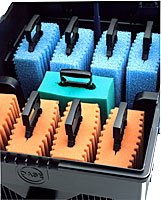
Foam has been widely used as a media for pond filters. Foam has excellent surface area for beneficial bacteria and is extremely effective when differing foam densities are used in the pond filter. Foam is also effective at removing suspended particles from the pond water.
The downside to foam is clogging. Tight foam catches too much debris and will clog rather quickly. Some pond filters require you to remove the foam and wash them off- messy!
OASE has designed filters that use foam and are very easy to clean. The new Biotec 5.1 & 10.1 pond filters are cleaned simply by opening a valve and raising the handle on each pad to clean it. Easy and fast! It only takes me about three minutes to thoroughly clean my OASE Biotec 10.1 pond filter! Speaking of clean, I haven't seen a cleaner water garden than the one in my front yard.
Monday, May 15, 2006
Dealing with String Algae Naturally
Algae thrives on excess nutrient and sunlight. Limiting either or preferrably both will help control algae your the water garden.
- Check your fish load. You should only have 1" of fish for every 10 gallons of water in your pond.
- Limit feedings. The less food you give the fish the less nutrient they will put back into the water.
- Use a good number and mix of aquatic plants to absorb excess nutrients from the pond water to starve out the algae.
- Use floating plants (water lilies, lotus, water lettuce, etc) to shade the water to limit the amount of sunlight entering the pond.
Thursday, May 11, 2006
Make Life Easy on Yourself!
Want a clean, healthy water garden with virtually no maintenance?
Here's some advice:
Here's some advice:
- Oversize your pond filter. Larger pond filters work better and require less frequent cleaning.
- Use a solids handling pond pump that won't clog. If this is not possible, install a pond skimmer to catch the debris before it reaches the submersible pond pump.
- Install a ultraviolet clarifier to eliminate any chance of green water.
- Use Clean-up Bacteria weekly to keep the pond bottom clean. This does wonders for the overall appearance of your water garden.
Wednesday, May 10, 2006
Get the Most From Your Aquatic Plants
Some handy tips:
- Divide & re-pot your plants annually. A growing plant blooms better and more frequently and remove nutrients from the pond water that would otherwise fuel algae growth. Root-bound plants grow very slowly and have fewer blooms.
- Fertilize with a good plant tablets monthly. Highland Rim makes one of the best fertilizer tablet on the market. It is more expensive, but it is larger than other tablets and has a great formulation. Water lilies and lotus do extremely well with this fertilizer.
Tuesday, May 09, 2006
Water Gardens & Garden Ponds
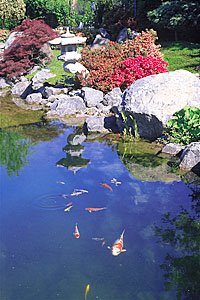 What made you first want a water garden?
What made you first want a water garden?Seeing other beautiful water gardens is what made me want a pond. There is a saying in the pond industry, "Everyone wants a water garden, most just don't know it yet."
What made you aware of water gardening? I'd like to know!
Monday, May 08, 2006
Multiple Pond Pumps?
Want that big waterfall for your water garden but don't want to pay and extra $60.00 a month to operate the pond pump?
When choosing a pond pump, it is easy to get torn between performance and energy costs. I'm a lot like Tim "the Tool Man" Taylor, I like more power, especially with a waterfall on my pond. On the other hand, I don't have any endorsement deals (yet) so money doesn't grow on trees around my house.
So, I chose both. I operate the Aquamax SF 3000 pump in the bottom of my pond that runs 24/7 amd feeds my pond filter. I have a second pump, an Aquamax 3700, in a pond skimmer that is set on a timer using a Cal Power Control Center.
The second pond pump doubles the size of my waterfall upon demand. And best yet, I am only paying for the extra energy usage when I want, not 24/7.
When choosing a pond pump, it is easy to get torn between performance and energy costs. I'm a lot like Tim "the Tool Man" Taylor, I like more power, especially with a waterfall on my pond. On the other hand, I don't have any endorsement deals (yet) so money doesn't grow on trees around my house.
So, I chose both. I operate the Aquamax SF 3000 pump in the bottom of my pond that runs 24/7 amd feeds my pond filter. I have a second pump, an Aquamax 3700, in a pond skimmer that is set on a timer using a Cal Power Control Center.
The second pond pump doubles the size of my waterfall upon demand. And best yet, I am only paying for the extra energy usage when I want, not 24/7.
Saturday, May 06, 2006
Pond Pumps
When choosing a pond pump for your water garden, it is important to choose the correct type of pump for your application.
Magnetic-drive pumps are the best choice for most small to medium sized water gardens. Mag-drive pumps use little energy and last for years. Most carry warranties of three to five years.
If you will be powering a large waterfall or a waterfall or stream that places a large amount of head pressure on the pond pump, a direct-drive may be rerquired.
Magnetic-drive pumps are the best choice for most small to medium sized water gardens. Mag-drive pumps use little energy and last for years. Most carry warranties of three to five years.
If you will be powering a large waterfall or a waterfall or stream that places a large amount of head pressure on the pond pump, a direct-drive may be rerquired.
Friday, May 05, 2006
Pond Pump
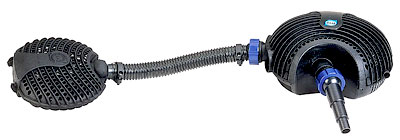
My waterfall and pond filter are powered by a OASE Aquamax SF 3000. The SF signifies the satellite pre-filter that allows a second intake into the pump for better circulation of the pond.
The pond pump was installed in the pond bottom so the entire pond is circulated, not just the top layers of the pond water that result from only using a submersible pump in a pond skimmer. As we rocked the pond bottom, the pond pump and second intake were disguised. Most people don't notice the pump unless they are looking for it.
The OASE Aquamax pumps are designed to move solids to the pond filter where they are removed. The pond pump is designed not to clog even with heavy sludge and leaves.
The best parts of the pond pump? A five-year warranty and it only uses 200 watts of energy. In Oklahoma, that's under $11.00 a month! No bad for a 18' x 19' water garden.
Pond Pumps
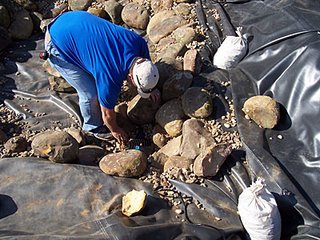
Thursday, May 04, 2006
Energy Costs
Always look at the energy costs when choosing your pond pump. An energy effcient pump will literally save you thousands of dollars over five years.
Here's a handy calculation for determine the energy cost for your pond pump:
(watts x 24) / 1000 x kilowatt hour cost = daily energy cost
Here's a handy calculation for determine the energy cost for your pond pump:
(watts x 24) / 1000 x kilowatt hour cost = daily energy cost
Wednesday, May 03, 2006
My Garden Pond
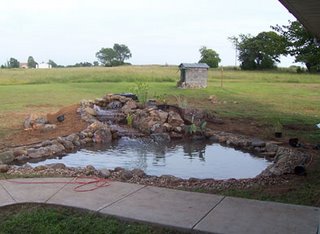
This is my water garden imeediately after installation last September. We came back a few days later and finished out the back of the waterfall. The pond filter at the top of the waterfall is now completely hidden.
I chose to use OASE products. I couldn't asl for a more energy-efficient system that keeps the pond clean with minimal maintenace. In the next few days, I'll spend some time expaning each part of the water garden. Happy ponding!
Tuesday, May 02, 2006
Algae on Waterfalls?
Here's and an easy trick to remove string algae from your waterfall in your pond.
Turn off your pond pump that powers your waterfall. Sprinkle CrystalClear D-Solv on the algae and let it sit for 20-30 minutes. Turn the pond pump on and the string algae should wash off the waterfall into the pond.
You may want to physically remove the algae from the water garden and use a clean-up bacteria such as CrystalClear Biological Clarifier to eat up any algae that you missed.
Both D-Solv and Biological Clarifer are safe for fish and plants and can be used at the same time with great results. Every water garden or pond owner should have both products.
Turn off your pond pump that powers your waterfall. Sprinkle CrystalClear D-Solv on the algae and let it sit for 20-30 minutes. Turn the pond pump on and the string algae should wash off the waterfall into the pond.
You may want to physically remove the algae from the water garden and use a clean-up bacteria such as CrystalClear Biological Clarifier to eat up any algae that you missed.
Both D-Solv and Biological Clarifer are safe for fish and plants and can be used at the same time with great results. Every water garden or pond owner should have both products.
Monday, May 01, 2006
Adding Lighting to Your Pond
Underwater and accent lighting adds so much to a water garden. It is truly amazing how beautiful a pond is at night. The koi seem to float through the air as they swim through the pond water. Pond lighting extend the amount of time that you cna enjoy your water garden- especially if you like to entertain at night.
Looking for a cheap way to add a light to your water garden? I recommend the Pontec Pondostar 20 light & transformer with a retail price of $29.00.
Looking for a cheap way to add a light to your water garden? I recommend the Pontec Pondostar 20 light & transformer with a retail price of $29.00.
Friday, April 28, 2006
OASE Pondovac 3 Review
The OASE Pondovac 3 pond vacuum is a major upgrade from its predecessor, the Pondovac 2. It seems to have more suctioning power and is much more "beefy" in appearance.
The Pondovac 3 runs continuously without pausing to allow the tank to drain during the vacuuming process which is a huge plus. I got finished much faster and my time spent cleaning the pond was more productive.
OASE added wheel to the Pondovac 3 to make transporting the pond vacuum easier. I have a large water garden which requires the vacuum to be moved two or three times. I found the wheels very convenient.
My overall experience with the OASE Pondovac 3 was positive. I recommend it to anyone with a pond up to 6000 gallons.
The Pondovac 3 runs continuously without pausing to allow the tank to drain during the vacuuming process which is a huge plus. I got finished much faster and my time spent cleaning the pond was more productive.
OASE added wheel to the Pondovac 3 to make transporting the pond vacuum easier. I have a large water garden which requires the vacuum to be moved two or three times. I found the wheels very convenient.
My overall experience with the OASE Pondovac 3 was positive. I recommend it to anyone with a pond up to 6000 gallons.
Thursday, April 27, 2006
Maintaining Good Water Quality in Your Pond
Limit your fish load. A good rule of thumb is 1 inch of fish for every 10 gallons of pond water. Keep in mind that fish grow and reproduce. Take in account the fish’s maximum size when stocking your pond.
Don’t overfeed the fish. Feed only what they’ll eat in a few minutes. Remove any uneaten food from the pond water.
Maintain your pond filter. Sludge on the filter media in the filter can suffocate beneficial bacteria causing the filter to crash.
Test your water quality regularly. Normal testing should include pH, ammonia and nitrite. The water quality in small ponds can change quickly.
Do water changes. Change 10% of the pond volume weekly or 20% every two weeks. Remember to dechlorinate your water if you are using a municipal water source
Don’t overfeed the fish. Feed only what they’ll eat in a few minutes. Remove any uneaten food from the pond water.
Maintain your pond filter. Sludge on the filter media in the filter can suffocate beneficial bacteria causing the filter to crash.
Test your water quality regularly. Normal testing should include pH, ammonia and nitrite. The water quality in small ponds can change quickly.
Do water changes. Change 10% of the pond volume weekly or 20% every two weeks. Remember to dechlorinate your water if you are using a municipal water source
Wednesday, April 26, 2006
The Water Garden Balancing Act
Too many fish can cause problems in your water garden. A general rule of thumb for most water gardens is 1 inch of fish for every ten gallons of pond water. A five hundred gallon water garden should contain a maximum of fifty inches of fish, or five ten-inch fish.
Keep in mind that fish grow throughout their entire life and fish, especially goldfish, reproduce. Always stock your water garden to match your fish’s expected maximum size. Koi routinely reach 26-30 inches while most goldfish will reach 14 inches.
Overstocked ponds will result in poor water quality and clarity. Fish disease and algae in the garden pond will become major issues if action is not taken in a timely manner.
Increasing the size of the pond filter may temporarily solve this problem but often the fish load must be decreased or the water garden size increased.
Keep in mind that fish grow throughout their entire life and fish, especially goldfish, reproduce. Always stock your water garden to match your fish’s expected maximum size. Koi routinely reach 26-30 inches while most goldfish will reach 14 inches.
Overstocked ponds will result in poor water quality and clarity. Fish disease and algae in the garden pond will become major issues if action is not taken in a timely manner.
Increasing the size of the pond filter may temporarily solve this problem but often the fish load must be decreased or the water garden size increased.
Tuesday, April 25, 2006
Pond Filters for Your Water Garden
Why do I need a pond filter?
Pond filters perform two vital functions for your pond. First, the pond
filter will clean the pond water make the pond clearer and healthier. But the main purpose of the pond filter is convert toxins in the water into substances that can be absorbed by the ecosystem. Ponds without filters, or that have poor or undersized filters, are usually dirtier and may have problems with water quality.
How does a pond filter work?
Most pond filters provide at least two of the three types filtration. These are:
Biological Filtration is performed by beneficial bacteria that break down ammonia in the water caused by fish waste, uneaten fish food and other naturally decaying organic matter. Nitrosmonas bacteria convert the ammonia into nitrites. Nitrobacter bacteria then convert the nitrites into less toxic nitrates. Aquatic plants then absorb the nitrates as food.
Mechanical Filtration is simply the removal of suspended particles from the pond water usually by a foam or polyester mat or pad in the pond filter. Generally the finer the media, such as foam, the more particles will be removed. But beware, the finer the media, the more maintenance the pond filter will require.
Chemical Filtration uses chemical processes to remove toxins from the pond water.
Zeolite is commonly used in the pond filter to trap ammonia from the pond water. Zeolite does become saturated with ammonia and should be "recharged" every two to three weeks. Simply soak the zeolite in a salt bath over night and rinse thoroughly. Salt causes the zeolite to release the captured ammonia and regain is effectiveness. Always remove zeolite from the filter before applying salt to the pond to avoid a deadly ammonia spike in the water.
What common mistake should I avoid when selecting a pond filter?
The most common mistake pond owner's make is selecting a pond filter rated for just at or below the pond's volume. By stretching the manufacturer's specifications, which may already be exaggerated, the pond filter may simply be too small to properly clean and filter the pond. The result will be a dirty, unhealthy pond with a pond filter that requires frequent cleaning. Always oversize the pond filter so that the pond will be cleaner, healthier with a pond filter that will need little maintenance. After all, who wants a dirty pond filter that needs to constantly be cleaned?
Pond filters perform two vital functions for your pond. First, the pond
filter will clean the pond water make the pond clearer and healthier. But the main purpose of the pond filter is convert toxins in the water into substances that can be absorbed by the ecosystem. Ponds without filters, or that have poor or undersized filters, are usually dirtier and may have problems with water quality.
How does a pond filter work?
Most pond filters provide at least two of the three types filtration. These are:
Biological Filtration is performed by beneficial bacteria that break down ammonia in the water caused by fish waste, uneaten fish food and other naturally decaying organic matter. Nitrosmonas bacteria convert the ammonia into nitrites. Nitrobacter bacteria then convert the nitrites into less toxic nitrates. Aquatic plants then absorb the nitrates as food.
Mechanical Filtration is simply the removal of suspended particles from the pond water usually by a foam or polyester mat or pad in the pond filter. Generally the finer the media, such as foam, the more particles will be removed. But beware, the finer the media, the more maintenance the pond filter will require.
Chemical Filtration uses chemical processes to remove toxins from the pond water.
Zeolite is commonly used in the pond filter to trap ammonia from the pond water. Zeolite does become saturated with ammonia and should be "recharged" every two to three weeks. Simply soak the zeolite in a salt bath over night and rinse thoroughly. Salt causes the zeolite to release the captured ammonia and regain is effectiveness. Always remove zeolite from the filter before applying salt to the pond to avoid a deadly ammonia spike in the water.
What common mistake should I avoid when selecting a pond filter?
The most common mistake pond owner's make is selecting a pond filter rated for just at or below the pond's volume. By stretching the manufacturer's specifications, which may already be exaggerated, the pond filter may simply be too small to properly clean and filter the pond. The result will be a dirty, unhealthy pond with a pond filter that requires frequent cleaning. Always oversize the pond filter so that the pond will be cleaner, healthier with a pond filter that will need little maintenance. After all, who wants a dirty pond filter that needs to constantly be cleaned?
Subscribe to:
Posts (Atom)



